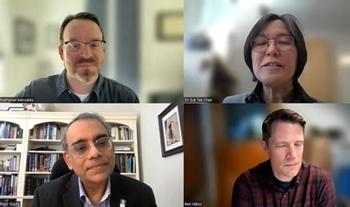Light Therapy Increases Brain Connectivity Following Injury
Released: May 28, 2024
- RSNA Media Relations
1-630-590-7762
media@rsna.org - Linda Brooks
1-630-590-7738
lbrooks@rsna.org - Imani Harris
1-630-481-1009
iharris@rsna.org
OAK BROOK, Ill. — Low-level light therapy appears to affect healing in the brains of people who suffered significant brain injuries, according to a study published today in Radiology, a journal of the Radiological Society of North America (RSNA).
Lights of different wavelengths have been studied for years for their wound-healing properties. Researchers at Massachusetts General Hospital (MGH) conducted low-level light therapy on 38 patients who had suffered moderate traumatic brain injury, an injury to the head serious enough to alter cognition and/or be visible on a brain scan. Patients received light therapy within 72 hours of their injuries through a helmet that emits near-infrared light.
"The skull is quite transparent to near-infrared light," said study co-lead author Rajiv Gupta, M.D., Ph.D., from the Department of Radiology at MGH. "Once you put the helmet on, your whole brain is bathing in this light."
The researchers used an imaging technique called functional MRI to gauge the effects of the light therapy. They focused on the brain's resting-state functional connectivity, the communication between brain regions that occurs when a person is at rest and not engaged in a specific task. The researchers compared MRI results during three recovery phases: the acute phase of within one week after injury, the subacute phase of two to three weeks post-injury and the late-subacute phase of three months after injury.
Of the 38 patients in the trial, 21 did not receive light therapy while wearing the helmet. This was done to serve as a control to minimize bias due to patient characteristics and to avoid potential placebo effects.
Patients who received low-level light therapy showed a greater change in resting-state connectivity in seven brain region pairs during the acute-to-subacute recovery phase compared to the control participants.
"There was increased connectivity in those receiving light treatment, primarily within the first two weeks," said study coauthor Nathaniel Mercaldo, Ph.D., a statistician with MGH. "We were unable to detect differences in connectivity between the two treatment groups long term, so although the treatment appears to increase the brain connectivity initially, its long-term effects are still to be determined."
The precise mechanism of the light therapy's effects on the brain is also still to be determined. Previous research points to the alteration of an enzyme in the cell's mitochondria (often referred to as the "powerhouse" of a cell), Dr. Gupta said. This leads to more production of adenosine triphosphate, a molecule that stores and transfers energy in the cells. Light therapy has also been linked with blood vessel dilation and anti-inflammatory effects.
"There is still a lot of work to be done to understand the exact physiological mechanism behind these effects," said study coauthor Suk-tak Chan, Ph.D., a biomedical engineer at MGH.
While connectivity increased for the light therapy-treated patients during the acute to subacute phases, there was no evidence of a difference in clinical outcomes between the treated and control participants. Additional studies with larger cohorts of patients and correlative imaging beyond three months may help determine the therapeutic role of light in traumatic brain injury.
The researchers expect the role of light therapy to expand as more study results come in. The 810-nanometer-wavelength light used in the study is already employed in various therapeutic applications. It's safe, easy to administer and does not require surgery or medications. The helmet's portability means it can be delivered in settings outside of the hospital. It may have applications in treating many other neurological conditions, according to Dr. Gupta.
"There are lots of disorders of connectivity, mostly in psychiatry, where this intervention may have a role," he said. "PTSD, depression, autism: these are all promising areas for light therapy."
"Effects of Low-Level Light Therapy on Resting-State Connectivity Following Moderate Traumatic Brain Injury: Secondary Analyses of a Double-blinded, Placebo-controlled Study." Collaborating with Drs. Gupta, Mercaldo and Chan were Maria G. Figueiro Longo, M.D., Jonathan Welt, M.D., Arman Avesta, M.D., Jarone Lee, M.D., Michael H. Lev, M.D., Eva-Maria Ratai, Ph.D., Michael R. Wenke, B.S., Blair A. Parry, B.A., Lynn Drake, M.D., Richard R. Anderson, M.D., Terry Rauch, Ph.D., Ramon Diaz-Arrastia, M.D., Kenneth K. Kwong, Ph.D., Michael Hamblin, Ph.D., and Benjamin Vakoc, Ph.D.
Radiology is edited by Linda Moy, M.D., New York University, New York, N.Y., and owned and published by the Radiological Society of North America, Inc. (https://pubs.rsna.org/journal/radiology)
RSNA is an association of radiologists, radiation oncologists, medical physicists and related scientists promoting excellence in patient care and health care delivery through education, research and technologic innovation. The Society is based in Oak Brook, Illinois. (RSNA.org)
For patient-friendly information on brain MRI, visit RadiologyInfo.org.
Video (MP4):

Video 1. Rajiv Gupta, M.D., Ph.D., Nathaniel Mercaldo, Ph.D., Suk-tak Chan, Ph.D., and Benjamin Vakoc, Ph.D., discuss their research on how low-level light therapy appears to affect healing in the brains of people who suffered significant brain injuries.
Download MP4
(Right-click and Save As)
Images (JPG, TIF):

Figure 1. Flow diagram of participant enrollment for the low-level light therapy trial. TBI = traumatic brain injury.
High-res (TIF) version
(Right-click and Save As)

Figure 2. Functional MRI brain maps of resting-state functional connectivity in representative age- and sex-matched participants. (A, B) Axial (top) and coronal (bottom) views show whole-brain connectivity, with the seed at the left (L) superior frontal region, in a 36-year-old female participant in the low-level light therapy (LLLT) treatment group (A) and a 38-year-old female participant in the sham treatment group (B) during the acute, subacute, and late-subacute phases (columns, from left to right, in both A and B) of traumatic brain injury recovery. (C) Axial (top left), coronal (bottom left), and sagittal (right) views in a 38-year-old female control participant are shown for comparison; the solid green circle in the sagittal view indicates the location of the left superior frontal seed region. The color bar indicates that brain regions with warm colors (red, orange, yellow) show resting-state fluctuations that have significant positive correlation (r of 0 to 1) with those of the left superior frontal region, and brain regions with cold colors (blue) show resting-state fluctuations that have significant negative correlation (r of −1 to 0) with those of the left superior frontal region. Brain regions that have functional connectivity with the left superior frontal seed in the LLLT-treated participant (arrowheads in A) but not in the sham-treated participant (arrowheads in B) are shown. The arrow in A additionally shows brain regions with positive correlation with the seed in the LLLT-treated participant, but negative correlation with the seed in the sham-treated participant (arrow in B).
High-res (TIF) version
(Right-click and Save As)

Figure 3. Connectograms show changes in connectivity strength as estimated by the differences in Fisher z-transformed correlation values between the (A) low-level light therapy (LLLT) and sham treatment groups and in the (B) LLLT treatment group and (C) sham treatment group, individually, from the acute to subacute phases of traumatic brain injury recovery. The parcellated brain regions are assigned unique colors based on the RGB color model, per the FreeSurfer neuroimaging software, and abbreviations are listed on the right. The number of brain region pairs with positive differences in connectivity strength is shown at the top of the connectogram in red, with those connections mapped with red-shaded lines in the connectogram. The number of brain region pairs with negative differences in connectivity strength is shown at the top of the connectogram in dark blue, with those connections mapped with blue-shaded lines in the connectogram. The darker the shade of red or blue lines, the larger the difference in connectivity strength, as indicated by the color bar. bankssts = banks of the superior temporal sulcus.
High-res (TIF) version
(Right-click and Save As)

Figure 4. Connectograms show changes in connectivity strength as estimated by the differences in Fisher z-transformed correlation values between the (A) low-level light therapy (LLLT) treatment group and (B) sham treatment group from the subacute to late-subacute phases of traumatic brain injury recovery. The parcellated brain regions are assigned unique colors based on the RGB color model, per the FreeSurfer neuroimaging software, and abbreviations are listed at the bottom. The number of brain region pairs showing positive differences in connectivity is shown at the top of the connectogram in red, with those connections mapped with red-shaded lines. The number of brain region pairs showing negative differences in connectivity strength is shown at the top of the connectogram in dark blue, with those connections mapped with blue-shaded lines. The darker the shade of red or blue lines, the larger the difference is in connectivity strength, as indicated by the color bar. bankssts = banks of the superior temporal sulcus.
High-res (TIF) version
(Right-click and Save As)


